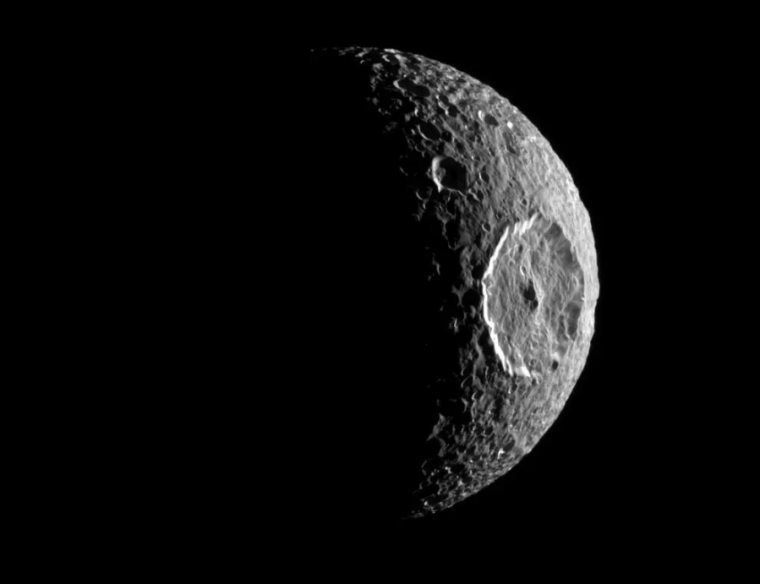
The once-exclusive club of Solar System objects that host oceans is getting increasingly crowded. On Wednesday, Nature released a paper providing evidence that Saturn's moon Mimas has a subsurface ocean beneath its heavily cratered crust. The evidence for this ocean comes in the form of orbital oddities that are seemingly impossible to explain by anything other than the presence of an ocean.
Solid looks
Of Saturn's seven major moons, Mimas orbits closest to the planet, taking less than a day to complete an orbit. It's also the smallest of the major moons, with a diameter of just under 400 kilometers (about 250 miles). Despite its diminutive size, Mimas hosts the second-largest crater on any moon in the Solar System. The Herschel Crater dominates the surface of the moon, giving it an appearance that evokes the Death Star.
Even outside of Herschel, the moon's surface is heavily pocked by craters, suggesting it has been static for most of the moon's history. That's in sharp contrast to moons like Europa and Enceladus, where the subsurface oceans allow the constant remodeling of their surfaces, leaving them with much sparser crater histories. So Mimas seemed like a very poor candidate for hosting an ocean.
Yet some oddities meant that an ocean couldn't be ruled out. Because of its proximity to Saturn, the moon is tidally locked to the planet so that its rotation is synchronized with its orbit, and one face of the moon constantly faces the planet's surface. Data from the Cassini mission, however, indicated that the synchronization isn't exact. Slight wobbles in the rotation mean that after some orbits, the rotation is slightly faster; after others, it has slowed down.
One possible explanation for that is a subsurface ocean. But an alternative is that Mimas' rocky core is oddly shaped, creating an opportunity for the gravitational pull of Saturn and the other moons to torque it somewhat differently each orbit. The lack of any surface geology that might hint at an underlying ocean seemingly argued for the latter option.
But in 2022, researchers calculated the amount of energy that would be generated by the tidal forces acting on Mimas and found that it should be enough to melt a substantial amount of the moon's ice, producing a subsurface ocean. While compelling, the evidence was based on a calculation rather than any hints from observations of Mimas itself.
Orbital oddity
That brings us to the new paper, which was written by a small team of European scientists who focused on a different aspect of Mimas' orbital mechanics, again using data from Cassini. Mimas has an elliptical orbit around Saturn, and over time, the long axis of the orbit shifts relative to Saturn. That's also caused by gravitational forces generated by the planet and other moons and provides a completely independent way of estimating what the moon's interior should look like.
Again, an oddly shaped rocky core was consistent with the orbital changes we've seen. But if you try to design a rocky core that is consistent with both the orbital and rotational wobbles, things get really strange. The core would need to be an oblong, pancake-shaped disk, with a shape so extreme that the edge of the disk would poke out of the icy surface of the moon at its two extremes. As the researchers dryly note, "This is incompatible with observations."
An ocean appears to be a far better option. The researchers estimated the extent of the ocean and found that it roughly matches the above estimate based on tidal heating.
So why don't we see signs of this ocean on the moon's surface? The researchers start with the present conditions and orbit and project Mimas' history back in time, estimating the amount of energy released by tidal forces. These calculations show that the ocean wouldn't have existed 25 million years ago—there simply wasn't enough heat generated. Depending on the nature of Mimas' core, it might have only come into existence as recently as 3 million years ago.
One explanation for why the ocean has appeared now is that Mimas had interactions with other moons that increased the eccentricity of its orbit and thus increased the tidal forces. Alternatively, if the rings of Saturn are as recent as some studies have suggested—a contention that's still controversial—then the events that led to ring formation might have also influenced Mimas' orbit.
It's not clear what sort of data will help us sort out these possibilities. But it's pretty clear that astronomers now have a good motivation for trying to think of things that might help.
Nature, 2024. DOI: 10.1038/s41586-023-06975-9 (About DOIs).


3175x175(CURRENT).thumb.jpg.b05acc060982b36f5891ba728e6d953c.jpg)
Recommended Comments
There are no comments to display.
Join the conversation
You can post now and register later. If you have an account, sign in now to post with your account.
Note: Your post will require moderator approval before it will be visible.